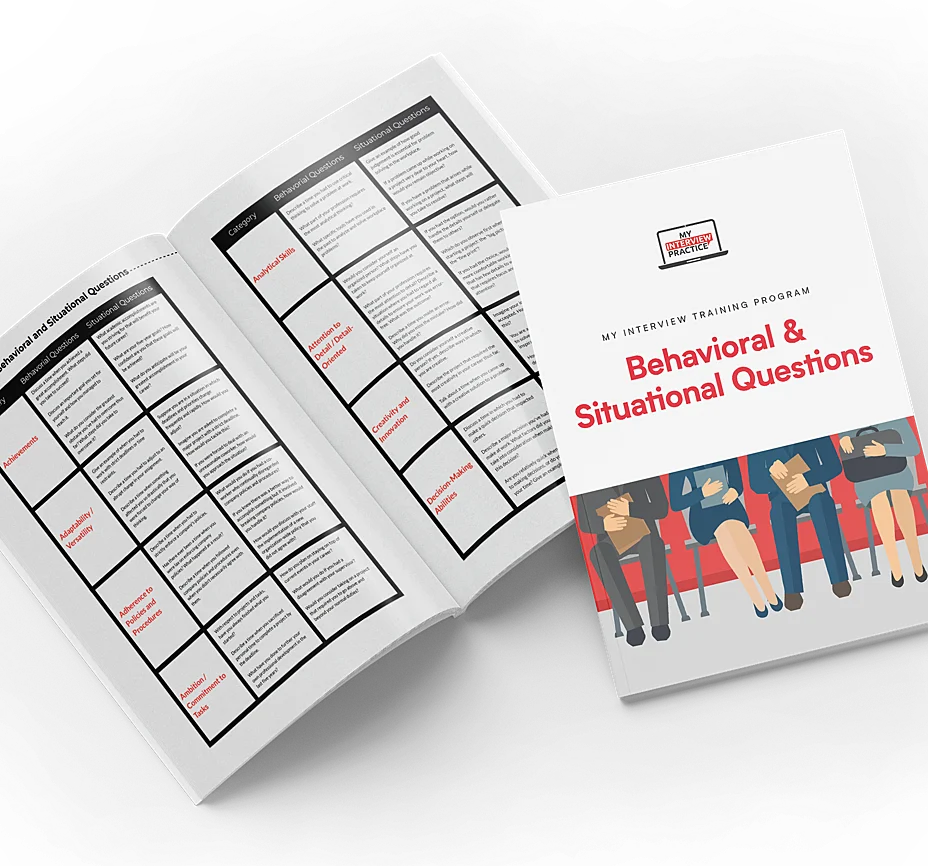 BACK
BACK
Data Scientist Interview Questions
Data scientists are the backbone of data-driven decision-making in modern organizations. They analyze complex datasets, build predictive models, and uncover insights that drive innovation and efficiency. Beyond technical expertise, data scientists must communicate their findings effectively to stakeholders, ensuring the value of their work is realized.
If you're preparing for a data scientist interview, you’ll need to demonstrate your technical skills, analytical thinking, and problem-solving abilities. To help you succeed, we’ve compiled 23 of the most common data scientist interview questions, complete with detailed explanations and example answers to give you an edge.
Data Scientist Interview Questions
1. What steps do you take to ensure the regression model fits the data?
This question tests your understanding of regression modeling, a cornerstone of data science. Interviewers want to assess your ability to evaluate and validate models to ensure accurate and reliable predictions.
Example Answer:
"There are several steps to ensure a regression model fits the data. I start by analyzing residual plots to check for randomness, which confirms the model captures the underlying patterns. Next, I use metrics like R-squared for explanatory power and RMSE for overall accuracy. I also perform cross-validation to test how well the model generalizes to new data."
2. Can you describe what a decision tree is and how it is used?
Decision trees are fundamental tools in data science for classification and regression tasks. Interviewers ask this to gauge your understanding of structured learning algorithms and their practical applications.
Example Answer:
"A decision tree is a flowchart-like structure used for decision-making or prediction. Internal nodes represent conditions based on features, branches represent decision outcomes, and leaf nodes indicate final predictions or results."
3. Why might you choose random forests over a single decision tree?
This question assesses your ability to evaluate different machine learning models and choose the best one for a given scenario.
Example Answer:
"Random forests are ensembles of decision trees that reduce overfitting and improve accuracy by averaging the predictions of multiple trees. This diversity helps the model generalize better to unseen data."
4. What is data wrangling, and why is it important in data science?
Interviewers ask this question to assess your ability to preprocess raw data, a skill essential for building reliable models.
Example Answer:
"Data wrangling is the process of cleaning, organizing, and transforming raw data into a usable format. This is crucial for ensuring that the models built on the data are accurate and reliable"
5. Why is it important to do data cleaning before applying machine learning algorithms?
Interviewers ask this question to understand your approach to preprocessing data and avoiding errors that could arise from noisy or inconsistent datasets.
Example Answer:
"Data cleaning is vital because machine learning algorithms are sensitive to inconsistencies, missing values, and outliers. Clean data leads to better model performance and interpretability."
6. Can you describe the differences between supervised and unsupervised learning?
This question evaluates your understanding of core machine learning concepts and your ability to distinguish between different types of algorithms. It’s important to explain not just the definitions but also examples of when each is used.
Example Answer:
"Supervised learning uses labeled data to train models for tasks like classification and regression. For instance, predicting house prices based on features is a supervised learning task. Unsupervised learning, on the other hand, deals with unlabeled data to find patterns or groupings, such as customer segmentation."
7. What are the assumptions required for linear regression?
Linear regression relies on specific assumptions to ensure valid and reliable results. Interviewers want to assess your understanding of these conditions and your ability to verify them when building models.
Example Answer:
"Linear regression assumes that there is a linear relationship between the independent and dependent variables, residuals are normally distributed, there is no multicollinearity among predictors, and homoscedasticity is present. In practice, I validate these assumptions using diagnostic plots and statistical tests."
8. Why do you think mean square error (MSE) can be a misleading metric for model performance?
This question probes your critical thinking about evaluation metrics. Interviewers ask this to ensure you understand the limitations of popular metrics and can select appropriate alternatives when necessary.
Example Answer:
"MSE can be misleading because it disproportionately penalizes large errors due to its squared term, making it sensitive to outliers. In some cases, mean absolute error (MAE) is more appropriate because it treats all errors equally."
9. What is cross-validation, and why is it important in model evaluation?
Cross-validation is a key method to assess model performance and generalizability. Interviewers ask this question to gauge your ability to ensure models are not overfitting and perform well on unseen data.
Example Answer:
"Cross-validation is a technique used to evaluate a model’s performance by splitting the dataset into training and testing subsets multiple times. It ensures the model generalizes well to new data."
10. How would you handle missing data in a dataset?
Handling missing data is a common challenge in data science. This question evaluates your understanding of various techniques to address missing values while minimizing bias.
Example Answer:
"Handling missing data depends on the context and the extent of the missingness. For small amounts of missing data, I use imputation techniques like mean, median, or mode. For larger gaps, I might use predictive models to estimate the missing values. In some cases, I drop rows or columns if they add little value"
11. What are outliers, and how do you deal with them?
This question assesses your ability to identify and manage outliers to ensure robust analyses. A good answer demonstrates awareness of different techniques and their trade-offs.
Example Answer:
"Outliers are data points that deviate significantly from the rest of the dataset. To identify them, I use visualization tools like box plots or statistical methods like Z-scores. Depending on the context, I may remove outliers, transform the data, or use robust models like decision trees that are less sensitive to them."
12. What is the difference between bagging and boosting in ensemble learning?
Interviewers ask this question to evaluate your understanding of these methods and their applications.
Example Answer:
"Bagging, or Bootstrap Aggregating, reduces variance by training multiple models on different subsets of the data and averaging their predictions. Boosting, on the other hand, focuses on reducing bias by sequentially training models, giving more weight to incorrectly predicted instances."
13. Why is feature scaling important in machine learning?
Feature scaling ensures that machine learning algorithms perform optimally, especially those sensitive to feature magnitudes. This question evaluates your understanding of preprocessing steps and their role in model performance.
Example Answer:
"Feature scaling standardizes or normalizes data so that all features contribute equally to the model. Algorithms like Support Vector Machines and K-Nearest Neighbors rely on distances, making scaling essential."
14. Can you explain what overfitting is and how to prevent it?
Overfitting occurs when a model learns noise instead of the underlying patterns. Interviewers ask this question to assess your ability to diagnose and mitigate overfitting in machine learning models.
Example Answer:
"Overfitting happens when a model performs well on training data but poorly on unseen data. To prevent it, I use techniques like cross-validation, simplifying the model, adding regularization, or gathering more data."
15. What is PCA, and when would you use it?
Principal Component Analysis (PCA) is a dimensionality reduction technique. This question assesses your understanding of its use in simplifying data without losing significant information. Interviewers want to see how you balance complexity and interpretability.
Example Answer:
"PCA reduces the dimensionality of data by transforming it into principal components, which capture the most variance. It is useful when dealing with high-dimensional datasets to improve computational efficiency or avoid multicollinearity."

The Smarter Way to Prepare
Experience a smarter way to prepare with our interview simulator.
16. What steps do you take to validate the results of a machine learning model?
Validation ensures the reliability and applicability of a model's predictions. This question tests your ability to use appropriate methods and tools to evaluate model performance comprehensively.
Example Answer:
"To validate a machine learning model, I start by splitting the data into training and testing sets. I use metrics like accuracy, precision, recall, and F1 score depending on the problem. Cross-validation provides a more comprehensive evaluation by testing the model on different subsets of the data."
17. What is the difference between supervised and unsupervised learning?
This fundamental question assesses your understanding of two primary machine learning paradigms. Interviewers want to evaluate your knowledge of when to apply each type of learning and the key distinctions between them.
Example Answer:
"Supervised learning involves labeled data, where the algorithm learns to predict an output based on input features, such as in regression or classification tasks. Unsupervised learning, on the other hand, deals with unlabeled data and is used to uncover hidden patterns or groupings, like clustering or dimensionality reduction."
18. Can you explain the concept of a confusion matrix and its components?
Understanding performance metrics is crucial for evaluating classification models. This question tests your ability to analyze and explain the confusion matrix, a common tool for evaluating model predictions.
Example Answer:
"A confusion matrix is a table used to evaluate a classification model’s performance by comparing predicted and actual values. Its components include True Positives (correctly predicted positives), True Negatives (correctly predicted negatives), False Positives (incorrectly predicted positives), and False Negatives (incorrectly predicted negatives)."
19. How do you decide which machine learning algorithm to use for a given problem?
This question evaluates your problem-solving approach and ability to match algorithms to specific use cases. Interviewers are looking for your understanding of algorithm strengths, weaknesses, and suitability based on data characteristics.
Example Answer:
"I consider several factors, such as the type of problem (classification, regression, or clustering), data size, computational resources, and the interpretability needed."
20. What is the curse of dimensionality, and how do you address it?
The curse of dimensionality refers to challenges that arise when dealing with high-dimensional data. This question tests your understanding of its implications and techniques to mitigate its effects.
Example Answer:
"The curse of dimensionality occurs when high-dimensional data leads to sparse samples, making it harder for models to generalize. To address it, I use techniques like dimensionality reduction (PCA or t-SNE), feature selection, or regularization."
21. How do you evaluate the performance of a regression model?
Regression evaluation is a crucial skill for data scientists. Interviewers ask this question to assess your familiarity with performance metrics and their interpretation.
Example Answer:
"I evaluate regression models using metrics like Mean Absolute Error (MAE), Mean Squared Error (MSE), and R-squared. Each provides unique insights, such as MSE penalizing larger errors and R-squared indicating the proportion of variance explained by the model."
22. What are some common challenges when working with time-series data, and how do you address them?
Time-series data introduces unique challenges like trend detection, seasonality, and autocorrelation. This question evaluates your ability to recognize and manage these challenges effectively.
Example Answer:
"Challenges in time-series data include non-stationarity, missing values, and autocorrelation. To address these, I use techniques like differencing to achieve stationarity, interpolation to handle missing values, and ACF/PACF plots to analyze autocorrelation."
23. Can you explain the bias-variance tradeoff and its significance in machine learning?
This fundamental concept is critical to building well-balanced models. Interviewers want to see your understanding of the tradeoff between model complexity and generalization.
Example Answer:
"The bias-variance tradeoff is about finding the right balance between underfitting and overfitting. High bias leads to underfitting due to overly simplistic models, while high variance causes overfitting by being too sensitive to training data. I manage this tradeoff by using techniques like cross-validation, regularization, or adjusting model complexity."
A word of warning when using question lists.
Question lists offer a convenient way to start practicing for your interview. Unfortunately, they do little to recreate actual interview pressure. In a real interview you’ll never know what’s coming, and that’s what makes interviews so stressful.
Go beyond question lists using interview simulators.
With interview simulators, you can take realistic mock interviews on your own, from anywhere.
My Interview Practice offers a dynamic simulator that generates unique questions every time you practice, ensuring you're always prepared for the unexpected. Our AI-powered system can create tailored interviews for any job title or position. Simply upload your resume and a job description, and you'll receive custom-curated questions relevant to your specific role and industry. Each question is crafted based on real-world professional insights, providing an authentic interview experience. Practice as many times as you need to build your confidence and ace your next interview.
| List of Questions |
In-Person Mock Interview |
My Interview Practice Simulator |
|
|---|---|---|---|
| Questions Unknown Like Real Interviews | |||
| Curated Questions Chosen Just for You | |||
| No Research Required | |||
| Share Your Practice Interview | |||
| Do It Yourself | |||
| Go At Your Own Pace | |||
| Approachable |
The My Interview Practice simulator uses video to record your interview, so you feel pressure while practicing, and can see exactly how you came across after you’re done. You can even share your recorded responses with anyone to get valuable feedback.
Check out My Interview Practice
Positions you may be interested in
Get the free training guide.
See the most common questions in every category assessed by employers and be ready for anything.
Get the Guide


